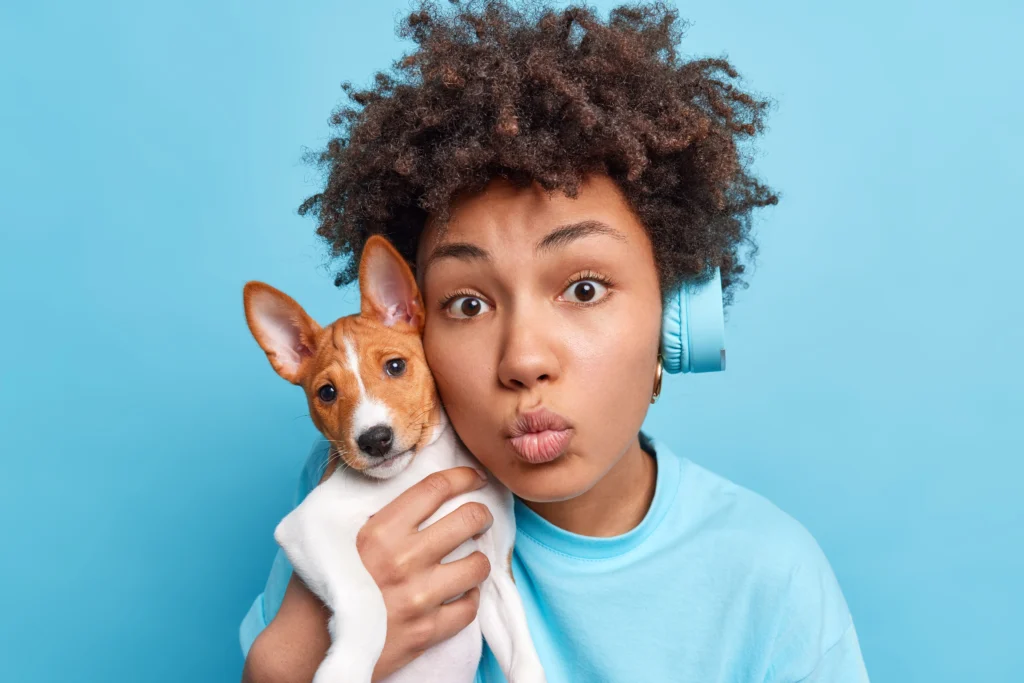Puppy Eyes Human. They’ve become a cultural phenomenon, captivating us in ways we can’t fully explain. We’ve all been there—standing face-to-face with a puppy, lost in those large, soulful eyes that seem to peer straight into our hearts. But what is it about these innocent-looking, doe-eyed gazes that draw us in? The allure is undeniable, but there’s more to it than just their cuteness. There’s a deep, almost primal connection between those puppy eyes and our emotions. In this article, we’ll explore the biology, psychology, and cultural impact of puppy eyes—and why we just can’t resist them.
What Are Puppy Eyes?
It’s the look. You know the one. Wide, pleading, and utterly irresistible. Puppy eyes are a dog’s version of a silent plea—an expression of vulnerability that seems to speak directly to our caregiving instincts. But this look isn’t just a random feature. It’s evolved, perfected, and strategically used by dogs to draw us in and keep us connected. You’ve probably seen it in a puppy begging for attention or a dog seeking comfort. It’s an expression of emotional need wrapped in an adorable package.
Why Are They So Appealing to Humans?
Humans, by nature, are drawn to the gaze of puppies because it triggers something deeply rooted in us—our nurturing instincts. The shape and size of their eyes mimic that of human infants, activating our protective urges. This reaction is hardwired into our brains; we’re biologically conditioned to respond to features like large eyes, round faces, and helpless expressions. It’s nature’s way of ensuring survival—whether for a human child or an adorable pup. We feel compelled to care for them.
The Science Behind Puppy Eyes
Evolutionary Psychology and Attachment
From an evolutionary standpoint, dogs have mastered the art of human interaction. Over thousands of years of domestication, they’ve learned to communicate with us in ways that resonate with our emotional wiring. Puppy eyes are no accident—they’ve evolved to make us more attached. When dogs look at us with those big, round eyes, it activates parts of our brain that are usually reserved for our own offspring. In this way, dogs are using the power of these expressions to foster emotional connections with humans, which in turn, strengthens the bond.
How Humans Respond to Puppy Eyes
Here’s where things get really interesting: when you lock eyes with a puppy, your brain releases a surge of oxytocin. Yes, the same hormone that helps mothers bond with their babies. This biochemical reaction makes us feel warm, affectionate, and deeply connected to the dog. It’s why you might find yourself offering an extra treat or a little more attention when that puppy gives you those big, soulful eyes. It’s an emotional response that’s not just about affection; it’s also a chemical response, a physical trigger that encourages bonding.
The Role of Oxytocin in the Bonding Process
Let’s take it a step further. Oxytocin doesn’t just make us feel good—it strengthens the bond between human and dog. When you gaze into those puppy eyes and oxytocin floods your system, the connection grows deeper. It’s not just a fleeting moment of affection; it’s the beginning of a long-term bond that can last a lifetime. This interaction is what turns a simple puppy into a beloved companion, a creature whose eyes will always beckon you for more attention.
Puppy Eyes and Emotional Manipulation
The Power of Expressive Eyes in Pets
Dogs are experts at reading human emotions. Their wide eyes are a reflection of their ability to tap into our deepest feelings. And let’s face it, we know the power of puppy eyes—it’s hard to ignore them. But are they just a cute feature, or is there something more to them? Some argue that puppy eyes are a tool—one that puppies use to get what they want. Whether it’s a treat, a cuddle, or even forgiveness for chewing on your favorite shoes, puppies have learned to use their eyes as a form of communication that effectively manipulates our emotions.
Do Puppies Use Their Eyes to Manipulate Humans?
In a way, yes. But let’s not be too harsh. It’s not manipulation in the sense that we humans manipulate each other—it’s simply learned behavior. Dogs have evolved to recognize that showing vulnerability through their eyes gets them what they need from us. It’s not a calculated move to deceive us; rather, it’s a strategy honed over centuries. They use it instinctively, not out of malice, but out of a desire to communicate and bond with us. And we—being the empathetic creatures we are—fall for it every time.
The Ethics of Emotional Manipulation in Pets
So, is it ethical to “manipulate” humans with puppy eyes? Well, the answer is complicated. Puppies aren’t capable of understanding manipulation the way humans do. For them, puppy eyes are a way to communicate needs, wants, and emotions. If anything, it’s a sign of how in tune they are with us. As for us, well, we tend to enjoy the emotional connection. So, perhaps it’s not about manipulation at all, but rather a mutual bond that strengthens over time.
Puppy Eyes in Popular Culture
Iconic Media Representations of Puppy Eyes
Puppy eyes have long been a staple of popular culture. From animated movies like Lady and the Tramp to real-life commercials, those big, pleading eyes are used to evoke strong emotional responses. In Lady and the Tramp, the puppy’s wide-eyed look is a symbol of innocence and affection. It’s a look that instantly makes us fall in love, which is exactly the point. Puppies, with their adorable eyes, have become an icon of emotional appeal, strategically used to sell everything from pet products to heartwarming tales of love.
The Influence of Cute Overload in Advertising and Marketing
In the world of advertising, puppy eyes are a powerful tool. Companies have long known that a cute puppy can increase consumer engagement. It’s why you see puppies featured in everything from pet food ads to car commercials. The message is simple: the puppy’s innocent gaze is not just a way to market a product—it’s a way to market an emotional connection. Puppy eyes elicit an emotional reaction that nudges us toward a purchase, not because we need the product, but because we want to nurture and protect.
The Psychological Impact of Puppy Eyes on Humans
Why Do We Feel the Urge to Care for Animals with Big Eyes?
Big eyes trigger something deep inside us. It’s not just about the cuteness factor; it’s about a deep-seated biological impulse. Large eyes, especially those of puppies, mimic the features of human infants, which naturally elicits our protective instincts. These instincts were honed over centuries of evolution to ensure that young creatures, including our own species, are cared for and protected. When we see a puppy with big, watery eyes, our brains automatically interpret it as a call for help, triggering a desire to provide care.
The Connection Between Puppy Eyes and Mental Health
But the connection isn’t just one-sided. Studies have shown that spending time with puppies can have a profound impact on mental health. The act of gazing into a puppy’s eyes, petting them, and sharing that bond can significantly reduce stress and anxiety. Puppies provide a sense of comfort and security, and that sense of well-being is reinforced every time we look into their eyes. They don’t just make us feel good—they make us feel understood.
Do Puppy Eyes Affect Human Behavior?
Studies on Puppy Eyes and Human Decision Making
It’s not just about how we feel—it’s also about how we act. Studies have shown that puppy eyes can influence human behavior. In one experiment, people were more likely to offer help to a dog in distress if the dog gave them a prolonged, soulful look. Puppy eyes have a powerful effect on decision-making, nudging us to act in ways that benefit the puppy. Whether it’s adopting a dog or simply offering it a treat, puppy eyes encourage us to take action, often in favor of the puppy’s needs.
How Puppy Eyes Influence Our Interactions with Dogs
Puppy eyes don’t just affect the way we feel—they affect the way we behave. When we see a puppy looking up at us with those big eyes, we’re more likely to engage with the dog, offer affection, and fulfill its needs. This bond strengthens the human-animal relationship, creating a cycle of positive interactions. The more we respond to those puppy eyes, the more puppies learn to use them to their advantage.
Real-Life Examples of Puppy Eyes in Action
Pet Owners Sharing Their Experiences
Pet owners have countless stories of how their puppies use their eyes to get what they want. One dog might give a sad look when it wants to go for a walk, while another may use its big eyes to beg for a treat. These real-life experiences show just how powerful puppy eyes can be in everyday life. They aren’t just cute—they’re tools for communication, understanding, and bonding.
Puppy Eyes and Their Impact on Animal Shelters
Puppy eyes also play a critical role in animal adoption. Shelters know that a dog’s expressive gaze can make all the difference in whether it gets adopted. Prospective pet owners often fall in love with a dog based on its eyes alone. It’s why many shelters focus on showcasing the eyes of their adoptable dogs—because those puppy eyes have the power to make hearts melt and decisions happen.
The Biology Behind the Cutest Gaze
Understanding the Anatomy of Puppy Eyes
So, what makes puppy eyes so enchanting? It’s a mix of biology and evolution. Puppies have larger eyes in proportion to their faces compared to adult dogs. This exaggerated size gives them a youthful, innocent look that triggers an emotional response in us. Their large, expressive eyes also allow them to communicate more effectively, conveying everything from joy to sadness with a single glance.
How the Shape and Size of Eyes Affect Perception
The shape and size of puppy eyes are key to how we perceive them. The roundness of the eye, the dark pupils, and the soft expression all contribute to making the puppy appear more vulnerable and in need of care. These features trigger our protective instincts, compelling us to respond with love and affection. The science behind puppy eyes is a beautiful example of how biology and behavior can work together to create an emotional connection.
Enhancing the Puppy Eye Effect: Can Dogs Be Trained?
Training Techniques to Emphasize Puppy Eyes
Believe it or not, some dogs can be



